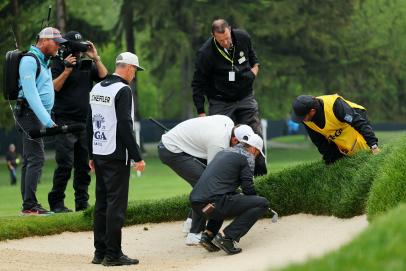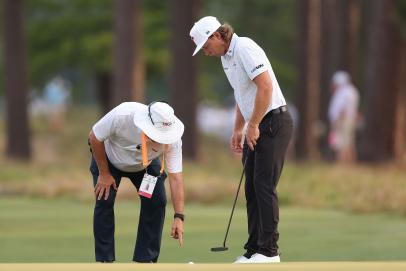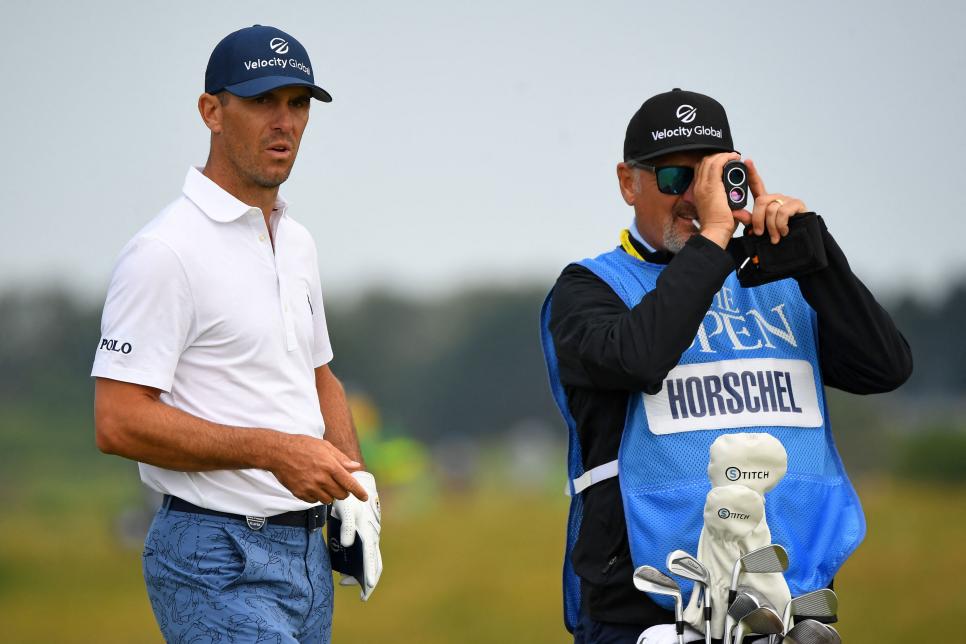Rules of Golf Review: You’re playing a course at altitude and need to adjust your distances. Can you use a calculator or smart phone during a round? – Australian Golf Digest

- by Admin
- August 21, 2024

The BMW Championship, the second leg of the PGA Tour’s FedEx Cup Playoff, is being held this week at Castle Pines Golf Club in Castle Rock, Colo. Aside from being among Golf Digest’s 100 Greatest Golf Courses in America, the Jack Nicklaus-designed course is notable for being at 6,400 feet above sea level. If you’ve never played a round on a course at significant elevation, you might not be aware that the ball travels farther because the air is thinner. (A little physics for you.)
The tour pros in the field certainly know this, and they and their caddies are doing a lot more math than usual in trying to figure out what clubs to hit at the course that’s hosting a PGA Tour event for the first time since 2006.
According to Steven Aoyama, a golf ball designer at Titleist, the general formula used to calculate the distance gain compared to sea level involves multiplying the elevation, in feet, by .00116. So, for example, when tour pros are playing in the Barracuda Championship in the Reno/Tahoe area, where the altitude is about a mile above sea level (5,280 feet), the increase comes out to about 6 percent (5,280 x .00116 = 6.1248). “If you normally drive the ball 250 yards, you will likely drive it 265 yards in Reno,” Aoyama says.
More From Golf Digest Rules Review Rules of Golf Review: I conceded a stroke thinking it tied a hole, but it gave my opponent a win. What now?  Rules Are you smart enough to ace this basic Rules quiz?
Rules Are you smart enough to ace this basic Rules quiz?  Rules What goes on inside the rules office at a major championship? We got a glimpse
Rules What goes on inside the rules office at a major championship? We got a glimpse
Interestingly, the distance gains don’t necessarily happen on short shots because the ball is moving slower and it’s not in the air long enough to be impacted. Also, sidespin is reduced, so shaping shots is more difficult. If you’re a slicer, you might want to head for the hills.
Getting back to Castle Pines, according to Aoyama’s formula, the pros will be looking at making a 7-percent adjustment to their distance yardages. For example, a 150-yard club at sea level will travel 161 yards. A 250-yard shot will go 268.
Wait … this is a Rules of Golf story, so where are we going with all this? Well, you might wonder if tour pros—or any golfers playing a round at altitude—are allowed to use a calculator or smart phone on the course to do some on-the-spot arithmetic, or do they have to do the math the old-school way with pencil and paper?
Here’s what the Rules of Golf states: Rule 4.3a allows regular golfers like you to use distance measuring devices, such as laser rangefinders or GPS watches, on the course, but only if the device doesn’t have a function that adjusts the yardage for elevation. If you use one that makes the adjustment, it’s a two-stroke penalty or loss of hole in match play.

Distance measuring devices are allowed for use under the Rules of Golf, but when playing in competitions you can’t use any enhancements that adjust for elevation changes. The PGA Tour, meanwhile, only allows them for use during practice rounds.
ANDY BUCHANAN
That means players have to calculate the distance difference on their own. Many players might do that before hand, creating a handy chart for quick reference, which is completely legal under the Rules, according to Craig Winter, the USGA’s Senior Director, Rules of Golf and Amateur Status. But if you had a calculator in your bag or a calculator app on your smart phone, could you use that on the course during the round? Winter says that this is not allowed under the Rules as addressed in Rule 4.3a.
As for pros on the PGA Tour, under Model Local Rule G-5, the use of rangefinders is limited only to practice rounds (although they were OK to use at the PGA Championship), which is why pros still carry around their trusty yardage books in their back pockets. You can bet, that every caddie at the event already has a pre-made yardage-conversion chart for Castle Pines.
MORE GOLF DIGEST RULES REVIEWS
What do I do if my ball just hit another ball on the green?
Can you chip a ball on the tee while waiting for the group ahead of you to play?
I hit myself with my own ball. Is that a penalty anymore?
What exactly is an embedded ball?
I hit a horrible shot. I’m way better off if I don’t find it. Can I just declare it lost?
When does the three-minute search time for a lost ball actually begin?
Does a ball have to be unplayable to declare it unplayable?
I accidentally hit my ball with a practice stroke … does it count?
I’m on the green. My opponent is not. Who’s away?
I bent my putter and it actually works better. Can I still use it?
Somebody just picked up my golf ball! Now what?
This article was originally published on golfdigest.com
The Latest News
-
January 10, 2025Kyrgios steps up Australian Open preparation in a positive sign
-
January 10, 2025Watch Hideki Matsuyama (unintentionally!) hit his ball through an 8-inch gap in palm trees – Australian Golf Digest
-
January 10, 2025PGA Tour monitoring Los Angeles fires with Riviera stop scheduled in four weeks – Australian Golf Digest
-
January 10, 2025Melbourne Cup prize money goes missing after error
-
January 10, 2025‘Picked for a reason’: Connolly embraces maiden Test tour | cricket.com.au





